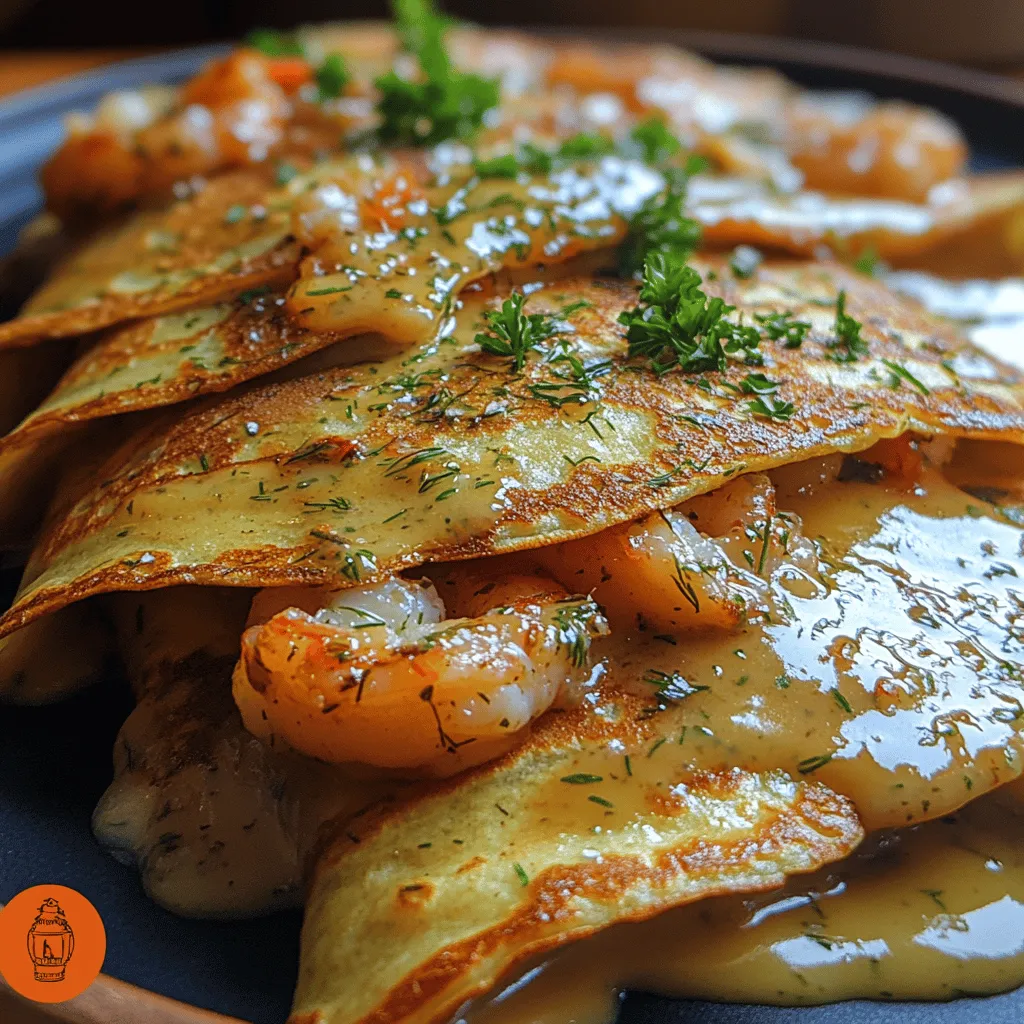Introduction
If you’re looking to elevate your home dining experience, few dishes can match the sophistication and comfort of seafood crepes. These delicate, thin pancakes envelop a rich and savory filling, making them a delightful option for both special occasions and cozy family dinners. The beauty of seafood crepes lies in their versatility; they can be adapted to suit your preferences, whether you crave the sweetness of fresh fruit or the richness of a savory seafood medley.
In this recipe, we’ll explore a unique twist on traditional crepes by filling them with an indulgent mixture of seafood, complemented by a luscious creamy sauce. This decadent dish not only tantalizes the taste buds but also makes a stunning presentation that is sure to impress your guests. Whether you’re a seasoned cook or a kitchen novice, our step-by-step guide will help you create this luxurious meal with ease.
Understanding Crepes
Crepes are a type of thin pancake that originated in Brittany, France, and have been embraced by cuisines around the world. The base ingredients are simple: flour, eggs, and milk, yet the possibilities for fillings are nearly endless. The versatility of crepes allows them to be enjoyed in both sweet and savory variations, making them a beloved dish for breakfast, lunch, dinner, or dessert.
Sweet vs. Savory Crepes
Sweet crepes are typically made with a slightly sweeter batter and are often filled with fruits, chocolate, or whipped cream. They are popular as a dessert or a breakfast option and are usually dusted with powdered sugar or drizzled with sauces. On the other hand, savory crepes, like our seafood crepes, tend to have a more neutral flavor profile, allowing for a wide range of savory fillings such as cheeses, meats, and vegetables. The choice between sweet and savory crepes ultimately depends on your cravings and the occasion.
Crepes hold a special place in French cuisine, symbolizing both simplicity and elegance. They can be found on the menus of upscale restaurants and charming bistros alike, showcasing their universal appeal. The art of making crepes lies in achieving the perfect thinness while ensuring they remain pliable enough to hold a variety of fillings without tearing.
Ingredients Breakdown
To create decadent seafood crepes, we will need a well-balanced selection of ingredients that contribute to both the crepe batter and the flavorful seafood filling. Let’s take a closer look at what you’ll need.
For the Crepes
– All-purpose flour: This is the backbone of our crepe batter. It provides the necessary structure and texture, allowing the crepes to be thin yet sturdy enough to hold the filling.
– Eggs: Eggs contribute moisture and richness to the batter, helping to achieve a smooth, pliable texture. They also play a crucial role in binding the ingredients together.
– Milk: Milk adds creaminess to the batter and helps achieve the desired consistency. You can use whole milk for a richer flavor, or opt for low-fat milk if you prefer a lighter version.
– Melted butter: This ingredient enhances the flavor and ensures that the crepes cook evenly without sticking to the pan. It also adds a touch of richness to the final product.
– Seasoning: A pinch of salt is essential for balancing the flavors, while fresh chives add a subtle onion-like flavor that complements the seafood filling.
For the Seafood Filling
The filling is where the magic happens, and choosing high-quality seafood will make all the difference in your dish.
– Shrimp: Fresh or frozen shrimp are ideal for this recipe. Their sweet and slightly briny flavor pairs beautifully with the creamy sauce.
– Scallops: These tender morsels add a luxurious touch to the filling. Look for dry-packed scallops, which are more flavorful than their wet counterparts.
– Crab meat: Lump crab meat provides a delicate sweetness and a lovely texture. If possible, choose fresh crab meat for the best flavor.
– Heavy cream: This ingredient is crucial for creating a rich and velvety filling that perfectly complements the seafood.
– Gruyère cheese: This Swiss cheese melts beautifully and adds a nutty, slightly sweet flavor that enhances the overall richness of the filling.
For the White Wine Sauce
A well-crafted sauce is essential for tying all the flavors together. Here’s what you’ll need:
– White wine: A dry white wine, such as Sauvignon Blanc or Chardonnay, adds acidity and depth of flavor that enhances the seafood. The wine’s brightness cuts through the richness of the cream, creating a balanced dish.
– Seafood stock: Using seafood stock instead of water or regular broth elevates the flavor profile, adding a savory depth that pairs perfectly with the seafood.
– Dijon mustard: A small amount of Dijon mustard lends a subtle tanginess to the sauce, enhancing the overall flavor without overpowering the delicate seafood.
– Fresh dill: This herb adds a refreshing note that complements the richness of the sauce and seafood, providing a burst of flavor with each bite.
Making the Crepes
Now that we’ve discussed the ingredients, let’s dive into the process of creating the perfect crepes. Making crepes may seem daunting at first, but with a little practice, you’ll find it to be an enjoyable and rewarding experience.
Preparing the Crepe Batter
1. Whisk the dry ingredients: In a mixing bowl, combine the all-purpose flour and a pinch of salt. Whisk them together to ensure they are well blended.
2. Combine wet ingredients: In a separate bowl, whisk together the eggs and milk until thoroughly combined. Then, stir in the melted butter and chopped chives.
3. Mix the batter: Gradually add the dry flour mixture to the wet ingredients, whisking continuously to avoid lumps. The goal is to achieve a smooth, lump-free batter with a consistency similar to heavy cream. If the batter is too thick, you can add a bit more milk to thin it out.
4. Resting the batter: Allow the batter to rest for at least 30 minutes at room temperature. This step is crucial as it helps the flour fully hydrate and results in tender crepes.
Cooking the Crepes
1. Preheat your pan: Heat a non-stick skillet or crepe pan over medium heat. Once hot, lightly grease the pan with a small amount of butter or oil.
2. Pour the batter: Using a ladle or measuring cup, pour a small amount of batter into the center of the pan. Immediately tilt and swirl the pan to evenly spread the batter into a thin layer.
3. Cook until set: Cook the crepe for about 1-2 minutes or until the edges begin to lift and the surface appears set.
4. Flip the crepe: Carefully slide a spatula under the crepe and flip it over. Cook for an additional 30 seconds to 1 minute until lightly golden.
5. Repeat: Transfer the cooked crepe to a plate and cover it with a clean kitchen towel to keep warm. Repeat the process with the remaining batter, greasing the pan as needed.
Once you’ve cooked all your crepes, you’re ready to move on to the delicious seafood filling that will make this dish truly decadent. Stay tuned for the next part of this recipe where we’ll dive into the preparation of the savory seafood filling and the white wine sauce that will complete your seafood crepes!
Techniques for Flipping Crepes Without Tearing
Mastering the art of crepe flipping is crucial for achieving perfectly delicate and intact crepes. Start by ensuring your pan is adequately heated and greased. Use a non-stick skillet or a crepe pan for the best results.
1. Prepare Your Utensil: A thin, flexible spatula is ideal for flipping crepes. If you don’t have one, a wide, flat knife can work in a pinch.
2. Check for Doneness: As the crepe cooks, watch for the edges to lift slightly and the surface to appear dry. This indicates it’s time to flip.
3. The Flip Technique: Gently slide the spatula under the crepe, ensuring you’re lifting from the center to avoid tearing the edges. With a quick motion, flip it over. If you’re feeling adventurous, you can try the traditional toss method, but this requires some practice.
4. Practice Makes Perfect: Don’t be discouraged if a few crepes tear during your first attempts. Each crepe is a learning experience, and soon, you’ll find your rhythm.
How to Keep Crepes Warm and Ready for Filling
Once you’ve successfully cooked your crepes, you’ll want to keep them warm while you prepare your seafood filling. Here are some effective methods:
1. Wrap in Foil: Stack your cooked crepes on a plate, cover them with aluminum foil, and place them in a warm oven (about 200°F or 90°C) while you finish cooking the filling.
2. Use a Slow Cooker: If you have a slow cooker, set it to the “warm” setting. Layer the crepes between parchment paper to prevent sticking.
3. Cover with a Towel: Another simple method is to wrap the crepes in a clean kitchen towel. This traps heat and keeps them warm without drying them out.
Preparing the Seafood Filling
Creating the perfect seafood filling is essential for your decadent seafood crepes. Follow these detailed instructions to ensure a delicious result.
1. Sautéing the Seafood: Begin by heating a tablespoon of olive oil and a tablespoon of butter in a large skillet over medium heat. Add finely chopped shallots or onions and sauté until translucent, about 2-3 minutes.
2. Cooking Times: Add the shrimp and scallops to the pan. Cook the shrimp until they turn pink and opaque (about 2-3 minutes), and ensure the scallops are seared on each side for about 2-4 minutes. Be careful not to overcook the seafood, as it can become rubbery.
3. Achieving Creamy Texture: Once the seafood is cooked, reduce the heat to low and pour in 1 cup of heavy cream. Stir in ½ cup of grated cheese (such as Gruyère or Parmesan) until melted and the mixture is creamy. If the sauce seems too thick, you can add a splash of seafood stock or additional cream until you reach your desired consistency.
4. Flavor Balancing: Taste the filling and adjust the seasoning with salt, pepper, and a squeeze of fresh lemon juice. Fresh herbs, such as parsley or dill, can also be added at this stage for enhanced flavor.
Crafting the White Wine Sauce
The white wine sauce adds depth and a sophisticated touch to your crepes. Here’s how to prepare it:
1. Preparation Steps: In a saucepan, combine 1 cup of dry white wine with 2 tablespoons of lemon juice and 1 tablespoon of minced garlic. Bring the mixture to a boil over medium-high heat.
2. Recognizing Proper Reduction: Allow the sauce to simmer until it reduces by half, which should take about 10-15 minutes. This concentration of flavors is critical for a rich sauce.
3. Achieving Consistency: To thicken the sauce, whisk in 1 tablespoon of butter at the end of the cooking process. This will give the sauce a glossy finish and a rich mouthfeel.
4. Role of Fresh Dill: Lastly, stir in 2 tablespoons of finely chopped fresh dill just before serving. The dill adds a beautiful herbal note and complements the seafood flavors perfectly.
Assembling the Seafood Crepes
Putting it all together is where the magic happens. Follow these instructions for a beautiful presentation:
1. Filling the Crepes: Lay a crepe flat on a clean surface. Spoon a generous amount of the seafood filling onto one half of the crepe, leaving space at the edges.
2. Folding Techniques: Fold the crepe in half over the filling, then fold it again to create a triangle or simply roll it up. You can choose your preferred method based on your presentation style.
3. Presentation and Garnishing: Arrange the filled crepes on a serving platter. Drizzle the white wine sauce over the top and garnish with freshly chopped parsley for a vibrant touch.
4. Plating Ideas: To elevate the dining experience, consider serving the crepes with a side of lightly dressed salad or steamed seasonal vegetables. This adds color and freshness to your plate.
Serving Suggestions
To enhance your seafood crepes, consider the following pairing recommendations:
1. Ideal Pairings: Seafood crepes pair beautifully with light, refreshing salads like a mixed greens salad with a citrus vinaigrette or a classic Caesar salad.
2. Side Dishes: Complement your meal with side dishes such as roasted asparagus, sautéed spinach, or even a light risotto which can serve as a comforting addition to the dish.
3. Wine Pairings: Since you’ve used white wine in your sauce, consider serving a chilled glass of the same wine alongside your crepes. A Sauvignon Blanc or a dry Chardonnay would be delightful choices that enhance the flavors of the dish.
Nutritional Information
Understanding the nutritional profile of your seafood crepes can help you make informed choices:
1. Nutritional Components: A serving of seafood crepes typically contains protein from the shrimp and scallops, healthy fats from the cream and butter, and carbohydrates from the crepes themselves.
2. Portion Sizes: Depending on your dietary needs, a serving size of two crepes with filling is generally satisfying. Adjust serving sizes based on the overall meal composition and guest preferences.
3. Health Benefits: Seafood is rich in omega-3 fatty acids, which are beneficial for heart health. Additionally, cream-based dishes, while indulgent, can be enjoyed in moderation as part of a balanced diet.
Conclusion
Making decadent seafood crepes is not just about feeding the body; it’s about creating an experience that brings joy and sophistication to your dining table. This dish is perfect for entertaining friends and family, celebrating special occasions, or simply enjoying a refined meal at home.
The versatility of crepes means you can experiment with different fillings, from savory to sweet, making this a staple recipe in your culinary repertoire. Encourage your guests to savor every bite, and share in the delight of a dish that embodies comfort and elegance. So, gather your ingredients, unleash your creativity in the kitchen, and dive into the delicious world of seafood crepes!


